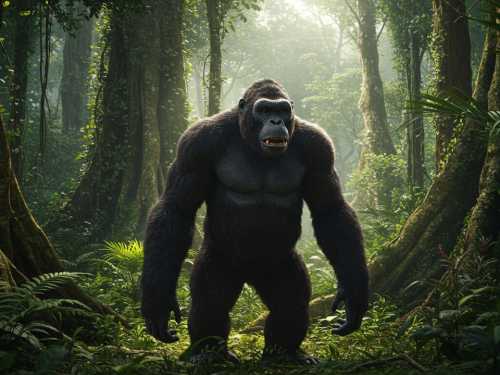
Being big is very convenient. You eat whatever you want, and no one eats you. You go wherever you want, and no one will stop you. And if you try, you will get slapped. A lot of animals have gone this way, and our relatives are no exception. Our today's hero is a giant who really existed and with his greatness could inspire the legends of Bigfoot, and not remain in the wet dreams of cryptozoologists. Meet the largest primate in history – Gigantopithecus!
Gigantopithecus is a genus of great apes. Unlike the Bigfoot, our hero lived in the jungles of Southeast Asia for quite a long time. Although his exact place on the family tree is still under debate, a common hypothesis suggests that he branched off from the orangutan lineage about 9 million years ago. According to the latest research (published in 2024), he became extinct between 295,000 and 215,000 years ago, having managed to interbreed with another species of humans that colonized Asia – Homo erectus.
Despite the fact that mostly only teeth and fragments of the lower jaw have been found, scientists have still calculated the size of these bibimaupes. It turned out quite well: according to estimates, if it had stood up to its full height, it could have reached 3 meters in height, and the weight ranged from 200 to 400 kilograms, and for the largest males – perhaps up to half a ton! However, like modern gorillas, they most likely moved on all fours. Outwardly, they could have resembled gorillas, but we can only guess about their coat color. A powerful body and jaw, perfectly adapted for chewing tough stems.
The latest adaptation turned these monkeys into walking bamboo processing factories. And thanks to their size, a pack of hungry giant primates could successfully compete for this resource with other lovers of tough grass – pandas, who lived in the same regions.
But then the strange things begin: often the remains of Gigantopithecus are found in caves, along with whole piles of bones of various ungulates. This makes you wonder: did our friend really like to feast on a couple of horses for lunch? However, most scientific data (the shape of the teeth, thick enamel, isotope analysis) indicates that Gigantopithecus was a purely herbivorous animal. More likely, the caves served as natural traps for animals or were a refuge for predators who left their victims (and possibly Gigantopithecus themselves) there.
In addition, sometimes in the same places as the late Gigantopithecus, primitive stone tools are found. Of course, most scientists consider them the work of early representatives of the genus Homo, who already inhabited these lands. But these rough and simple stones, which were probably too large for the hands of our ancestors, would have been perfectly suited for the paws of this giant! However, despite all the temptation of the imagination of a giant craftsman, there is no evidence that Gigantopithecus used tools. As for its brain – although we do not have skulls, most estimates indicate that, despite the gigantic size of its body, its intelligence was most likely at the level of modern apes, not humans.
Being big is very convenient. But as the climate becomes drier, bamboo forests shrink, and in addition, representatives of Homo erectus come from the west – more agile and omnivorous relatives of humans, who actively developed new territories and competed for resources, it becomes almost impossible for such specialized giants to survive. Gigantopithecus did not pass this test, replenishing the collection of our fossil relatives. Now no one will say whether these “gorillas at maximum speed” could have built a civilization if natural conditions had not become so cruel to them. Just imagine what would have happened if we shared the planet with these giants!





